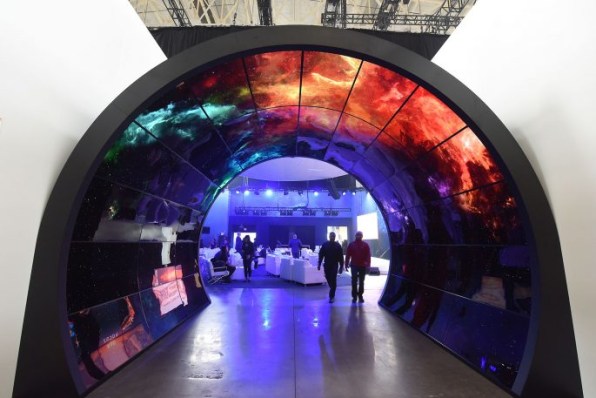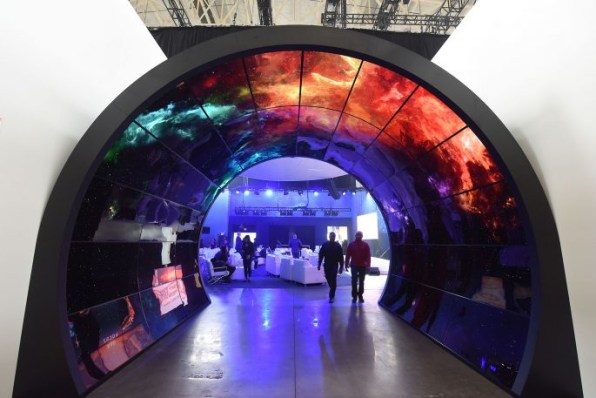
17 Nov Inside Royal Caribbean’s Wild, Tech-Filled Cruise Of The Future
At a recent press event at the Brooklyn Navy Yard, a large screen made up of light and smoke addressed each guest by name as they walked through it—a neat trick that left even the most jaded journalist in attendance stunned.
It was just a hint of what Royal Caribbean cruises—and its sister company, Celebrity Cruises—have in store for customers as they prepare to sail into the future. That may be a groan-inducing dad joke of a line, but as the company rolls out augmented reality safety features, virtual reality fun, facial-recognition-enabled drink delivery, and apps that can see through walls, it’s pretty apt.
The company offered a sneak peek at some of these products, which will roll out to about 50% of Royal Caribbean and Celebrity Cruise lines in 2018.
From the looks of things, the future of cruising is pretty wild. At the event, guests were asked to download an app, snap a selfie, and turn on their Bluetooth. Once those steps were taken, the techie magic took over. Guests were greeted by name, thanks to Bluetooth signaling. Pull up the app’s drink menu, make your choice, and a server delivers it wherever you are in the crowd thanks to a face-recognition system. Cruisers will undoubtedly appreciate that last feature when they are lounging next to one for the many pools that dot the ocean liners in Royal Caribbean’s fleet.
“Technology is hard to do, and it’s not simply a science, it’s also an art.” said CEO Richard Fain at the event, called Sea Beyond. “Now, though, technology is no longer just a nice thing to have. The truth is, technology is something people expect.” That has led Royal Caribbean to unveil better onboard Wi-Fi , add tech-enabled WOWbands (which serve as both room key and wallet), introduce skydiving and surf simulators, and unleash robot bartenders.
Leading the company’s digital transformation is Jay Schneider, who came on board Royal Caribbean after spending 10 years making literal magic at the Walt Disney Co. (He helped develop the park’s interactive MagicBand wristbands.) Schneider is tasked with integrating tech that improves safety, streamlines the travel experience, is sustainable, and adds a little fun for guests across all 49 ships that make up its six-brand fleet. The upgrades must also be in line with Fain’s list of priorities, which include frictionless, simple technology that is continuously improving and easy to use for cruisers of all ages and tech ability.
“We want it to be so intuitive that it works for whatever age you are,” says Schneider.
That simplicity extends from the design of the company’s new, straightforward app, which is so point-and-click simple that guests may not realize it’s using facial recognition to enable servers to bring you a cocktail, and can offer virtual reality tours of on-shore excursions.

Royal Caribbean is incorporating tech throughout the cruising experience, even before guests get onboard. The company is working on developing an AI-fueled interface that can mine your family’s schedule and interests to help you figure out the perfect time and place to take a vacation. “It will look at that data you have already put in your calendar, so that you don’t have to have to go dig it up yourself,” said Schneider.
Once tickets have been purchased, RCI is rolling out a driverless shuttle to take guests around its new Miami terminal, bringing virtual reality dining onboard, dabbling in immersive entertainment, and streamlining the boarding process by creating a system with “less friction.” Selfies and face recognition let guests skip the check-in lines. Their bags are tracked, and they are alerted when their luggage is in their stateroom. “We want to give guests their first day of vacation back,” Fain says.
Tech is also integrated into the staterooms, starting with doors that unlock with a flick of the wrist (and the WOWband attached to it). The accompanying app can tell you when to leave to make your dinner reservations, give guests the ability to chat with each other, and serve as a virtual concierge.
RCI not the first cruise company to go high tech, of course. Carnival has its Ocean Medallion, Norwegian Epic uses facial recognition to sell guests’ photos, and Cunard’s Queen Mary 2 implemented some high-tech features as well. It’s all part of cruise companies trying to appeal to very connected customers who not only want to be able to access the internet 4,000 miles from land, but want to be entertained in an increasingly high-tech way.
For RCI, the tech is a way to not only keep up with competition, but hopefully do it bigger and better than its competition. The strategy appears to be working for RCI, which cruised (ahem) to $1.28 billion in profits last year, with overall revenue climbing to $8.5 billion in 2016, up 2.4% from the previous year. (Although, Carnival with its focus on smaller ships and more affordable trips, earned nearly twice that with $16.4 billion in revenue, up from $15.7 billion in the prior year.)
The State Room Of The Future
While still just a concept, RCI’s space-age stateroom is reminiscent of work being done by NASA to improve the lives of astronauts. “We discovered that NASA’s biggest challenge for their spaceships is the same as that of cruise cabin spaces—the lack of an environment, visually speaking,” said an RCI tour guide at the event. “NASA found the thing the crew desired most was nature.”
The stateroom solves that by turning walls into nature via digital installations that “bring a little bit of the outside in,” according to an RCI employee showing off the space at the New York event. “We wanted to create a space where people could see views of the ocean and skies from inside their cabin, without having to necessarily go to the promenade of the ship.” The effect is completed by piping in the rhythmic sounds of calming waves or gentle rain showers, and having a faux sunrise serve as an alarm clock and the night sky revealed on the concept cabin’s ceiling.
Royal Caribbean is also using tech to help improve the cruise industry’s abysmal environmental reputation, with an ultimate goal of leaving a zero-carbon footprint. (Admittedly, it’s hard to imagine it’s possible for a 200,000-ton cruise ship to shuttle 5,000 guests across the ocean and leave no carbon footprint.)
“People now expect and demand we operate business in a sustainable manner,” said Fain in his keynote address. To that end, the New York event was powered by the company’s new highly efficient fuel cell, and the cruise line has a new an “air lubrication system” that coats the hulls of ships with millions of microscopic air bubbles to help reduce resistance and drag and in turn fuel consumption.
In the bridge, they are implementing some Star Trek-looking digital boards that let them monitor the goings-on in the engine and with the fleet around the world. “We have a live feed of data come in from every ship at about a six-second delay, depending on where it is in the globe, to return the information to Miami,” explains Schneider.
They are also using augmented reality to help steer the ship in low visibility. And soon, in the unlikely event of an onboard emergency, they are hoping to have tech that will reveal the location of every single guest on the ship.
While the bridge is off-limits, if guests want to see what is happening inside, RCI is working on a mind-blowing app feature that lets guests see through the cabin walls by holding up their phone. “I have to credit Richard for that,” says Schneider. “He said, you have to go find ways that people just can have fun. This is a vacation dammit!”
RCI is rolling out the newfangled technology to its fleet in stages, but they are hoping to have it in 50% of the fleet by 2019, with installation across all ships expected by 2020. Book your tickets for the future now—dad jokes not included.
Source: Fast Company




Sorry, the comment form is closed at this time.